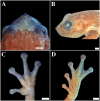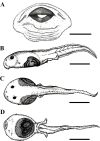A new large canopy-dwelling species of Phyllodytes Wagler, 1930 (Anura, Hylidae) from the Atlantic Forest of the state of Bahia, Northeastern Brazil
- PMID: 32612879
- PMCID: PMC7319025
- DOI: 10.7717/peerj.8642
A new large canopy-dwelling species of Phyllodytes Wagler, 1930 (Anura, Hylidae) from the Atlantic Forest of the state of Bahia, Northeastern Brazil
Abstract
The known diversity of treefrogs of the genus Phyllodytes has rapidly increased in recent years, currently comprising 14 species. Recent field work in the Atlantic Rainforest of the state of Bahia lead to the discovery of a new large species of Phyllodytes which is herein described based on multiple evidence including morphological, acoustical and genetic data. Phyllodytes sp. nov. is one of the largest species within the genus and presents immaculate yellowish dorsum and limbs. The advertisement call of the species is composed of 7-31 notes (half pulsed/pulsatile-half harmonic) with frequency-modulated harmonics. Phyllodytes sp. nov. has a karyotype of 2n = 22 chromosomes, as also found in other species of the genus. Genetic distance values of the 16S mitochondrial rRNA among Phyllodytes sp. nov. and its congeners range between 6.4 to 10.2%. The description of another new species for this state reinforces the need for further taxonomic work with Phyllodytes in this region that has been revealed as a priority area for research and conservation of this genus.
Keywords: Amphibia; Biodiversity; Bromeliad; Integrative taxonomy; Lophyohylini.
©2020 Dias et al.
Conflict of interest statement
The authors declare there are no competing interests.
Figures








References
-
- Altig R, McDiarmid RW. Body plan: development and morphology. In: McDiarmid RW, Altig R, editors. Tadpoles: the biology of anuran larvae. The University of Chicago Press; Chicago: 1999. pp. 24–51.
-
- Baldissera Jr FA, Oliveira PSL, Kasahara S. Cytogenetics of four Brazilian Hyla species (Amphibia –Anura) and description of a case with a supernumerary chromosome. Brazilian Journal of Genetics. 1993;16:335–345.
-
- Beeman K. Digital signal analysis, editing, and synthesis. In: Hopp SL, Owren MJ, Evans CS, editors. Animal acoustic communication: sound analysis and research methods. Springer Verlag; Berlin: 1998. pp. 59–103.
-
- Blotto BL, Lyra ML, Cardoso MCS, Rodrigues MT, Dias IR, Marciano-Jr E, Vechio FD, Orrico VGD, Brandão RA, Assis CL, Lantyer-Silva ASF, Rutherford MG, Gagliardi-Urrutia G, Solé M, Baldo D, Nunes I, Cajade R, Torres A, Grant T, Jungfer KH, Silva HR, Haddad CFB, Faivovich J. he phylogeny of the Casque-headed Treefrogs (Hylidae: Hylinae: Lophyohylini) Cladistics. 2020 doi: 10.1111/cla.12409. Epub ahead of print 2020 27 March. - DOI - PubMed
-
- Bokermann WCA. O gênero Phyllodytes Wagler, 1830 (Anura, Hylidae) Anais da Academia Brasileira de Ciências. 1966;38:335–344.
LinkOut - more resources
Full Text Sources
Miscellaneous

